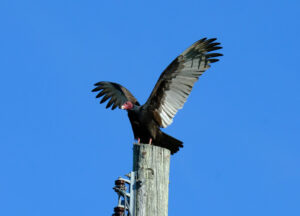As the latest strain of avian influenza—Gs/GD HPAI, it’s called—spreads through the U.S., birds are not the only creatures the virus has felled.
As of December 2022, the virus has been detected in a confirmed total of 53 red foxes in eight states. Other mammals have tested positive as well, including scavenger species, such as skunks and raccoons, that have likely fed on potentially infected dead birds. So far, 10 species of land mammals have tested positive for the virus in the U.S.
About this story
Wildlife epidemiologists say Gs/GD HPAI is the deadliest and most infectious bird flu ever to strike Europe or North America. Bay Area wildlife hospitals are on the front lines, and they’re facing the burden of extreme biosecurity measures to try and keep their patients safe from the virus.
In the Winter 2023 print issue of Bay Nature, Guananí Gomez-Van Cortright traces the history of this avian pandemic and explores what’s so strange about this strain. Read it here: The Latest Bird Flu Pandemic Is Terrible—And Strange
Workers at the Dane County Humane Society in Wisconsin received call after call about red fox kits behaving oddly. The kits were strangely easy to approach, wandering alone, often stumbling or walking in circles. Some struggled to stand, salivated excessively, twitched, and even had seizures, symptoms often soon followed by death. The Humane Society facility admitted some of the sick kits and ruled out rabies and other potential causes before testing revealed that the young foxes were suffering from neurological symptoms triggered by Gs/GD HPAI. Possibly because of the young foxes’ underdeveloped immune systems, the virus proved particularly lethal to them.
In June, the National Oceanic and Atmospheric Administration declared an unusual mortality event for gray seals and harbor seals, which were stranding on the beaches of Maine at three times the normal rate. Four of the eight beached seals tested were positive for Gs/GD HPAI, and over the next five months, over 300 seals were stranded. No birds were found in the stomachs of necropsied seals, but scientists believed the seals were catching the virus from contact with infected birds or their droppings when they came to shore.
Florida residents discovered a young male bottlenose dolphin trapped between a pier and a seawall in March. By the time rescuers got to the scene, the dolphin was dead. Bird flu wasn’t on their short list of possible culprits. But after researchers ruled out common causes and found high levels of inflammation in the dolphin’s brain during the necropsy, one researcher noted cases of avian influenza in wild seabirds in the area. The dolphin’s tissue samples tested positive for Gs/GD HPAI. The following September, Swedish researchers reported finding the virus in a stranded porpoise. These two cases marked the first time an avian influenza has ever been detected in cetaceans.
“We’ve had marine mammals that have been infected,” says Pitesky. “That gives me some pause.”
While it does sicken and kill mammals, Gs/GD HPAI does not seem to spread readily from one mammal to another. But the more spillover infections occur across animal classes, the higher the chances the virus could become capable of spreading between mammals as well.
“The worst-case scenario is, it finds its way to us,” says Richard Webby, an infectious disease and influenza expert at St. Jude Children’s Research Hospital in Memphis, Tennessee. “Those hosts, that’s a step closer to the virus changing from being a bird virus to being a human virus.”
Read the full story from the Winter 2023 print issue: The Latest Bird Flu Pandemic Is Terrible—And Strange





